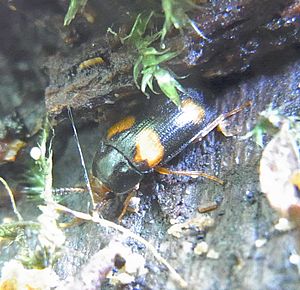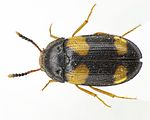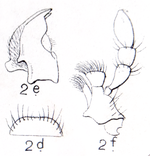Spotted tree sponge beetle
| Spotted tree sponge beetle | ||||||||||||
|---|---|---|---|---|---|---|---|---|---|---|---|---|

Spotted tree sponge beetle |
||||||||||||
| Systematics | ||||||||||||
|
||||||||||||
| Scientific name | ||||||||||||
| Mycetophagus quadripustulatus | ||||||||||||
| ( Linnaeus , 1761) |

|

|
| Fig. 1 top view | Fig. 2 side view |

|

|
| Fig. 3 front | Fig. 4 bottom |

|
 
|
| Fig. 5 and 6: top right and left: fore tarsus female (♀), bottom left foreleg male (♂), bottom right front tarsus ♂; Drawings on the left after Reitter , on the right photos with colored copies |
|

|

|
| Fig. 7: Mouth parts d upper lip, e upper jaw f lower jaw with jaw probe |
|
| Fig. 8: Head, after Reitter | |
| Fig. 9: Sensor (not colored) | |
The Vierfleckige Baumschwammkäfer also Vierfleckiger Mushroom Eater ( Mycetophagus quadripustulatus ) is a beetle from the tree sponge beetle family . The genus Mycetophagus comprises 35 species worldwide , twelve of which can be found in Europe. The European species are assigned to seven different subgenera. The four-spotted tree sponge beetle belongs to the subgenus Mycetophagus , which is represented by two species in Europe.
Notes on the name
The species was first described by Linnaeus in 1761 under the name Chrysomela quadripustulata as the 549th species of the genus Chrysomela . The description begins with the words Supra nigra, elytris rufo bimaculatis ( Latin: black on top, with two red spots on the wing cover ). So there are four spots on the two wing covers. This explains the species name quadripustulatus from Latin quádri- (four in word combinations) and pustulātus (provided with pustules) as well as the epithet Vierfleckig of the German name.
When the large genus Chrysomela is split up , the species is converted several times and finally, after the construction of the mouthparts, Fabricius initially assigned it to the genus Ips . Hellwig takes over and refines the natural system from Fabricius based on the mouthparts and supplements it with further features. He separates mycetophagus from the genus Ips . Among other things, he states: The species of this genus ... live on sponges, which is why I derived the name from μυκητός (sponge) and φάγω (I eat). This explains the names of tree sponge beetles and fungus eater from the generic name Mycetophagus ( old Greek μύκης, μύκητος mýkes, mýketos, mushroom and φαγός phágos, eater). Fabricius took over the division and the name as early as 1792.
Physique of the beetle
The elongated elliptical beetle has a flat arch. The pronotum and elytra are black except for the red-yellow spots on the elytra, the underside, head and legs are rust-red. The beetle becomes five to six millimeters long.
The orange-red head is densely hairy (Fig. 3 and 8). The eyes are wider than they are long and set out in front. The eleven-link antennae (Fig. 9) thicken outwards, the last four links are somewhat wider. The yellow terminal link is slender and about as long as the two preceding links together. The basal five links are red-brown, the sixth to tenth links dark. The upper lip (Fig. 7 2d) covers the upper jaw (Fig. 7 2e). These end with two teeth, are membranous on the inner edge and have a moon-shaped smooth grinding surface at the root. The lip and jaw buttons are thread-shaped. The two basal links of the small three-part lip stylus are approximately inversely conical, the end link oval. The end link of the large four-part jaw probe is trimmed.
The pronotum is as wide at the back as the wing-covers, towards the front it narrows in a semicircle to the width of the head. The posterior angles are acute, the lateral margin is smooth-edged, not finely notched (Fig. 2). The pronotum is densely dotted , hairy brown and doubled at the rimmed base. On the right and left in front of the label there is a clear basal dimple. In rare cases the pronotum is rust-red.
The wing covers nestle closely to the breast shield. Typically, they each have a large, oval-shaped spot at the base and a small cross-oval behind the middle. The hair on the elytra above the spots is red, otherwise black. Local varieties are described, Edmund Reitter mentions four deviations. The front or rear or all of the blemishes can be missing, on the other hand they can also be particularly large and flow together.
Seen from above, both sides of the wings are visible. Each wing cover has eleven rows of dots that are not deepened in strips.
In the male, the anterior tarsi are tripartite (Figs. 5 and 6 below). For this reason, Geoffroy described the species in 1762 without using the binary nomenclature as Tritoma , la tritôme ( fr. , Derived from Old Gr ., The tripartite). The front tarsi of the female (Fig. 5 and 6 above) and the remaining tarsi of both sexes are four-limbed.
Construction of the larva
The larva of the last instar becomes about eight millimeters long. It is approximately cylindrical and somewhat flattened. The red-brown head has two pale antennae that are stretched out far forward. The mandibles are slightly asymmetrical. The brown back is covered with horny, shiny plates that are edged at the sides. The plates are darker on the front and lighter on the back, so that the larva appears striated. The underside is soft-skinned and white. The first part of the chest is the same length as it is wide, the following about a third shorter than it is wide, only a little longer than the abdominal segments. These are about half as long as the first breast section and almost the same width as this. They have longer brown bristles on the back and weaker brown bristles on the belly. The abdomen ends in a urogomph with pointed ends pointing upwards. The six relatively long legs have pointed end hooks. The larvae move lively and quickly in the corridors.
biology
The species is found mainly on tubular mushrooms and porlingen , rarely also on lamellar mushrooms , mostly in forests. They prefer fresh and almost fresh mushrooms of various species, the hyphae and spores of which they eat. They have also been found on strong fungal branches of various hardwoods and on rotten trunks of trees.
The species occurs from the plains up to montane altitudes, but is absent in alpine regions.
The adults don't like to fly, but they are nimble runners.
The larvae develop in the fruiting bodies of the mushrooms. They leave these in late summer to pupate under tree bark, in rotten wood or in the ground.
distribution
The species is distributed all over Europe, only from most of the islands and a few small states there are no records. In Scandinavia the occurrence is limited to the southern areas. The distribution area extends beyond North Africa and to the east of Siberia.
literature
- Heinz joy, Karl Wilhelm Harde, Gustav Adolf Lohse (ed.): The beetles of Central Europe . tape 7 . Clavicornia. Spektrum Akademischer Verlag, Munich 1967, ISBN 3-8274-0681-1 . P. 194
- Klaus Koch : The Beetles of Central Europe Ecology . 1st edition. tape 2 . Goecke & Evers, Krefeld 1989, ISBN 3-87263-040-7 . P. 219
- Gustav Jäger (Ed.): CG Calwer’s Käferbuch . K. Thienemanns, Stuttgart 1876, 3rd edition p. 239 f
- Svatopluk Bílý: Coléoptères, adaptation française Verlag Gründ 1990; ISBN 2-7000-1824-9 , p. 156
- Wolfgang Willner: Pocket dictionary of the beetles of Central Europe . 1st edition. Quelle & Meyer, Wiebelsheim 2013, ISBN 978-3-494-01451-7 . P. 294
Individual evidence
- ↑ a b c d Edmund Reitter : Fauna Germanica, the beetles of the German Empire III. Volume, KGLutz 'Verlag, Stuttgart 1911, p. 92
- ↑ a b Mycetophagus quadripustulatus in Fauna Europaea. Retrieved December 3, 2013
- ↑ Taxon profile Mycetophagus Hellwig, 1792. BioLib, accessed on December 7, 2013, and 11 subpages.
- ↑ Mycetophagus in Fauna Europaea. Retrieved December 3, 2013
- ↑ Mycetophagus (subgenus) in Fauna Europaea. Retrieved December 3, 2013
- ^ C. Linnæus: Fauna Svecica sistens animalia Sveciæ Regni: mammalia, aves, amphibia, pisces, insecta, vermes. Distributa per classes & ordines, genera & species, cum differentiis specierum, synonymis auctorum, nominibus incolarum, locis natalium, descriptionibus insectorum 2nd and increased edition, Stockholm 1761 pp. 217: 168
- ↑ Sigmund Schenkling: Explanation of the scientific beetle names (species)
- ↑ Hellwig, JCL Third message from new genera in the entomological system Latest magazine for lovers of entomology Volume 1 Issue 4 pp. 385-408 Stralsund. 1792. pp. 280: 394
- ↑ Sigmund Schenkling: Explanation of the scientific beetle names (genus) .
- ↑ J. Ch. Fabricius: Systema entomologiae, sistens insectorvm classes, ordines, genera, species, adiectis synonymis, locis, descriptionibvs, observationibvs . Actes de la Société d'histoire naturelle de Paris, vol. 1, part 1, Paris 1792 at GDZ, on page 74:30 genus Tritoma
- ^ EL Geoffroy: Histoire abrégée des insectes qui se trouvent aux environs de Paris; dans laquelle ces animaux sont rangés suivant un ordre méthodique . Tome 1, Paris 1762 at GDZ p. 369: 335 f
- ↑ Gv Frauenfeld: " Boletophagus agaricola Fbr, Diaperis boleti L. and Mycetophagus Mycetophagus quadripustulatus L." Negotiations of the Imperial-Royal Zoological-Botanical Society in Vienna, vol. 17 1867 p. 780 at BHL
- ↑ Mycetophagus (Mycetophagus) quadripustulatus. Coleoptera Poloniae, accessed December 7, 2013.
